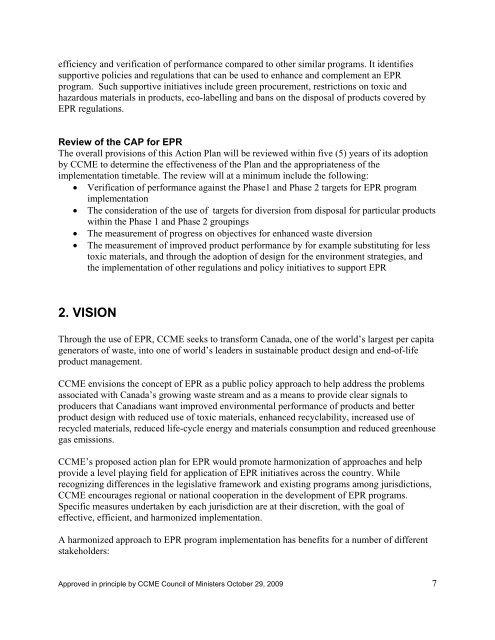Canada-Wide Action Plan for Extended Producer ... - CCME
Canada-Wide Action Plan for Extended Producer ... - CCME
Canada-Wide Action Plan for Extended Producer ... - CCME
You also want an ePaper? Increase the reach of your titles
YUMPU automatically turns print PDFs into web optimized ePapers that Google loves.
efficiency and verification of per<strong>for</strong>mance compared to other similar programs. It identifies<br />
supportive policies and regulations that can be used to enhance and complement an EPR<br />
program. Such supportive initiatives include green procurement, restrictions on toxic and<br />
hazardous materials in products, eco-labelling and bans on the disposal of products covered by<br />
EPR regulations.<br />
Review of the CAP <strong>for</strong> EPR<br />
The overall provisions of this <strong>Action</strong> <strong>Plan</strong> will be reviewed within five (5) years of its adoption<br />
by <strong>CCME</strong> to determine the effectiveness of the <strong>Plan</strong> and the appropriateness of the<br />
implementation timetable. The review will at a minimum include the following:<br />
• Verification of per<strong>for</strong>mance against the Phase1 and Phase 2 targets <strong>for</strong> EPR program<br />
implementation<br />
• The consideration of the use of targets <strong>for</strong> diversion from disposal <strong>for</strong> particular products<br />
within the Phase 1 and Phase 2 groupings<br />
• The measurement of progress on objectives <strong>for</strong> enhanced waste diversion<br />
• The measurement of improved product per<strong>for</strong>mance by <strong>for</strong> example substituting <strong>for</strong> less<br />
toxic materials, and through the adoption of design <strong>for</strong> the environment strategies, and<br />
the implementation of other regulations and policy initiatives to support EPR<br />
2. VISION<br />
Through the use of EPR, <strong>CCME</strong> seeks to trans<strong>for</strong>m <strong>Canada</strong>, one of the world’s largest per capita<br />
generators of waste, into one of world’s leaders in sustainable product design and end-of-life<br />
product management.<br />
<strong>CCME</strong> envisions the concept of EPR as a public policy approach to help address the problems<br />
associated with <strong>Canada</strong>’s growing waste stream and as a means to provide clear signals to<br />
producers that Canadians want improved environmental per<strong>for</strong>mance of products and better<br />
product design with reduced use of toxic materials, enhanced recyclability, increased use of<br />
recycled materials, reduced life-cycle energy and materials consumption and reduced greenhouse<br />
gas emissions.<br />
<strong>CCME</strong>’s proposed action plan <strong>for</strong> EPR would promote harmonization of approaches and help<br />
provide a level playing field <strong>for</strong> application of EPR initiatives across the country. While<br />
recognizing differences in the legislative framework and existing programs among jurisdictions,<br />
<strong>CCME</strong> encourages regional or national cooperation in the development of EPR programs.<br />
Specific measures undertaken by each jurisdiction are at their discretion, with the goal of<br />
effective, efficient, and harmonized implementation.<br />
A harmonized approach to EPR program implementation has benefits <strong>for</strong> a number of different<br />
stakeholders:<br />
Approved in principle by <strong>CCME</strong> Council of Ministers October 29, 2009 7
















